



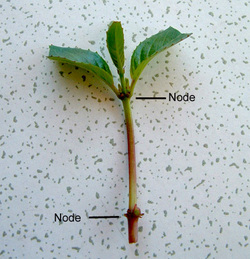



 Many of us have been busy doing this over the past few weeks, planting hanging baskets. Indeed you may have yours planted a good 2 months by now, planting them up and then allowing them to thicken up in a polytunnel of greenhouse before putting them pride of place at the front of the house. On Saturday past I held a Hanging Basket Planting workshop on behalf of the Ballymagroarty and Hazelbank Community Area Partnership (BHCAP), Holy Family Mens Health Club and Springtown Activity Group. Thsi event was very well attended and for £2 you got to plant up a basket and take it home, all the materials were provided...amazing value....well over the next 3 coming saturdays we're exploring techniques for planting pots, window boxes and then some examples of edible containers...  the plant we used as a centrepiece is Fuchsia (white eyes was the variety), one of my all-time favourite plants. This is the plant which got me into Gardening - i've two uncles back home in Scotland who grow them and breed new varieties so i've always had a fondness for them since then. When you buy a Fuchsia plant it'll be about the £2 mark...a pretty price where you have 10 or more to buy, well these fellows root fierce easy from cuttings, cutting taken now will be rooted and ready to pot up in about 3-4 weeks and will be blooming by the end of summer, and in turn you can take more cuttings of them in late summer for over-wintering in a cold frame or greenhouse for next year....plants for nothing but a bit of spare time...  Now the process of takign the cutting benefits you and the overall display, hanging basket plante are best 'pinched back' when you plant them, the idea is here that when you pinch back the long growth it encourages the plant to produce 4 or more new stems in its place, thus giving you many more flowers and a bushier habit. Now the cuttings your taking are really these 'pinched out' bits, heres a picture of us taking summer cuttings from Fuchias during a Hroticulture class in North West Regional College. You'll see in the pots that the student is taking more than 1 cutting into the pot, this is to maximise return on space, not every cutting will take so by having 3 or more in a pot your ensuring some return on your space.  we go through every basket pinching back long growths, thus giving us plenty of materials to propogate and produce more plants from  Heres a great picture I found on-line showing what your cuttings should look like, you can clearly see the nodes (these are where the leaves come out from) - you can see the lower leaves have been removed, this part of the cutting will be below soil level so leaves are not needed, also at the top of the cutting the growing-tip has been removed and the top leaves have been reduced in size. With these fuchsia cuttings I don't bother with rooting powder, the growth is so green and fresh the plants don't need it to root. Place 3 or 5 into a pot, around the inside rim. The pot will be filled with a mix of multi-purpose compost and perlite.  You need to protect the cuttings from wilting to death, so to reduce water loss place the cuttings into a bag and tie the bag or onto a tray and cover with a plastic lid. Place the cuttings in a warm placve, away from direct sunlight, so on the shelf below the bench in the polytunnel or similar. Once a week open the bag and check for any rot and to make sure they've not went dry or anything, then tie the bag back up, repeat this until you can see new growth, when you see new growth remove the bag.  After 3-4 weeks your cuttings should be well enough rooted for them to be potted up into fresh compost into individual pots, we're been doing this all this past week in the college. Here you can see some cuttings with nice root systems just starting. In the compost you can see the flecks of white perlite.  and you'll have a scene like this soon enough....lost of free plants....enjoy!!
1 Comment
 the best thing about planting...is the harvesting. Harvesting in a school is tricky...no point in leaving or having stuff ready in the school holidays, so we tend to do some out-of-the-normal growing to ensure produce is ready before or after the schools holidays. Here is kids from Blighs Lane Nursery harvesting loads of garlic and spinach  I grow courgettes with all the schools, i know i know....'but they're ready in the summer', aye they are, but before the schools break we can get a steady harvest for the last few weeks of the terms and if I pop in a few times to harvest in the summer the plants are still cropping in September 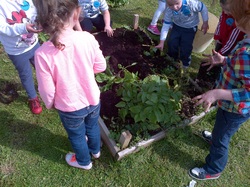 and the things kids love is hunting for buried treasure, and searching for gold nuggests of new potatoes kids love. The potatoes are small, but really tasty, we leave a few of the bags and ridges in some school un harvested so we can lift some in september too  its great to show off a bit in schools too, let parents and other visitors see the good work kids have been doing, today in St Therese we set up a harvest table in the reception showing some of the fabulous stuff the kids have been growing...and perhaps encourage them to do the same at the house (we keep a weekly scrapbook of what the kids do - thats the book).....anyways, what are you harvesting??  Blighs Lane Nursery is a great wee school based up in Creggan. For the past 2 years i've been working with the kids there on and off, but this year i've been able to be there steady throughout the year. We've a nice wee set-up there, with wee raised beds, herb pots, perennials, evergreens, insect habitats, hedgehog houses....but the one thing we never had is Scarecrows...so we put that to an end this year. The kids took to the idea of making a scarecrow like ducks to water.....thankfully mrs gillen's husband 'donated' some clothes lol for Sam....  in no time at all we had mr scarecrow made....he was swiftly named Sam 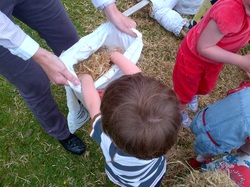 special gusto was giving to the stuffing of the head with straw....they loved this part...  Now...we had Sam complete and up.....the putting him up was kinda hard work....little did I know that the green hill is a hill 'cos its all rock...but we tried and tried and eventually got a hole big enough to stand him up in..  but Sam looked lonely and the girls decisded that he needed a Mrs Scarecrow to keep him company...so it was back for more Straw (big bags easily got from Harkins Lawnmower repair place in Springtown ind est - 1 bag did the two scarecrows)  and a happy marriage was made....Sam met Sally...sally met sam and they were destined to spend their lifes together. But the kids were worried about them being all alone during the summer holidays, so we decided to give our friends in Fountain Primary School a ring and see if they could make use of them for their Community Garden...and they said they'd be delighted....(we traded the 2 for 40 trees and 12 strawberry plants)  So we took all the kids from Blighs Lane Nursery upto the Fountain PS to perform the 'hand over' ceremony. Great fun was had on the day, all the kids mixing and playing together. Sam and Sally now stand tall and proud in the Fountain CommunityGarden to keep the pigeons away from their cabbages and strawberries....a great project and a great way for kids from different areas to mix...and a partnership was borne between the Blighs Lane Nursery and Fountain Nursery.  Comfrey is some mighty stuff. Fact. I use it at every garden project i'm involved with. It make the most wonderful of liquid fertiliser, and you can chop it up and use it fresh as a mulch around plants and at the time of planting put some leaves down with the roots of the plants. I gather wild comfrey, there are lots of locations (I'll tell you a great one soon). The common wild comfrey is Symphytum officinale, you'll see this in abundance down at Inch Island Wildfowl Reserve and in many other damp fertile lands. Comfrey is really a weed, a mad self-seeding weed. But one, which when harnessed has an ability to produce the most wonderful of flower-right fertiliser, without a single additive or chemical in sight (and for nothing!!) 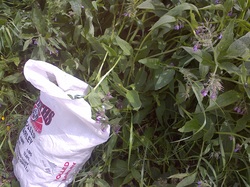 Comfrey is brilliant, we've established that, but where it gets its brilliance is in its massive roots, these long roots extended many feet deep into the soil and tap into many nutrients and bring them right up into the foliage. The plants are easily identified at this time of the year due to their small purply/blue flowers. I gather Comfrey as often as I can, most Sundays I take a walk and a coal bag and gather a fresh bag. The leaves are the best bit, but all the stems and stalks will make fertiliser. Cut it or break the stems and the plant will re-grow quickly and be able for another harvest in 3 weeks or so.  I find the comfrey fierce prickly (not a stingy but an uncomfortable shaprness) so I woos it a bit and wear ma Gauntlet gloves...mighty things these.  One of my favourtie places for gathering Comfrey is Inch Island Wildfowl Reserve in Burt, Donegal. The Comfrey there is fierce accessible (growing alongside the path) and abundant in nature - the picture is all comfrey....right ot the end of the concrete path. which is conveniently located right at the car park...  A favourite method of mines to use Comfrey is to 'brew' it to make a liquid fertiliser. Simply break the stems and leaves up and add to a bucket (try to pack as much into the bucket as you physically can - a good few presses with a childs foot generally helps the process) and top up with water. Place a lid on it and leave for 6 weeks or so, stirring every week. We started a new bucket up in St Marys PS in Altinure, Park Village today, should be nice and ready for when the kids return from holidays.  Now this liquid fertiliser will smell, really bad. But the liquid it produces will do wonders for your soil and your plants. you diliute the liquid about 1 part liquid to 10 parts water and feed it every week to your tomatoes, hanging baskets, peas, beans, onions, spuds...really whatever you fancy. It won't make things grow overnight but it will give your plants a steady supply of nutrients which will keep them blooming happy...and cost you nothing...This picture is my own bucket at the house, I have it on the go from Mid April till late September. I grow a variety of Comfrey at the hosue which doesn't produce seeds (blo cking 16 or something), and i grow this beside the hen run, i empty all the fresh manure on it and the comfrey sucks it up and grows like beejaysus!  The stewed Comfrey will honk, Connie referes to it as 'Daddys smelly water' but she loves to help pour it around the plants in the garden. The old sludge that the leaves create in the bucket is mega stuff for the compost bin, it rots down super quick and gives a real boost to the composting process...is there anything this plant can't do??  September is looking like a busy one in the NWRC Springtown, there are anumber of Horticulture courses offered, from Hobby right through to city and guilds level 2. NWRC is all about hands on learning, experiencing horticulture by doing it....plant propagation, tree and shrub maintenance, soil science, plant biology all covered in hands-on style...thus ensuring participants get lots of practical skills by the completion of any of our courses. The following courses are pencilled in to start: Monday, start 3rd September. City & Guilds Diploma in Organic Gardening, running over 34 weeks, from 4-7pm Tuesdays, start 4th September. City & Guilds Level 1 Practical Horticulture Skills, running over 20 weeks, this diploma course offers a the participant to experience many skills and get a grasp of academic learning, from 3.30-5.30. Tuesdays, starting 4th September, Hobby Seasonal Gardening. Running for 10 weeks from 6-8pm. This offers participants to dip their toe into many areas of seasonal gardening, seed swoing, lawn care, garden layout, trimming and maintenance all geared towards the season we're in. Thursdays, starting 6th Septemner, City&Guilds Diploma in Horticulture. Running for 34 weeks from 4-7. This substantial award is ideal for those employed in the landscape sector and wishing a relevant practical qualification, this award is matched into the CAFRE college (Greenmount) and offers excellent progression onto their Foundation Degree Course. Fridays, starting 7th September, Hobby Seasonal Gardening. (as above) Further information can be found by contacting [email protected] All courses are subject to the relevant number of students enrolling, are are subject to a max class size of 16.  This week we talked about Courgette rot. This is where the end of the Courgette rots, this is due to the flowers getting a hammering from rain (or sprinklers). The best action here is to remove the fruit and discard it, thus allowing the energy to be refocussed on producing more flowers and fruit, the best prevention is to try and avoid getting the flowers un-necessarily wet. 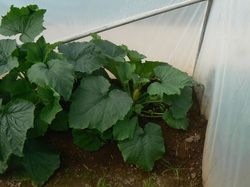 I love growing courgettes, I grow them inside polytunnels and outside in raised beds. I grow a number of different varieties, golden, green, striped etc but kinda follow the same guidlines with them all. Feed them plenty!!.....oh and give them lots of sunshine. The picture on the right is an entire row of Courgettes planted inside Gillespie Polytunnels, we planted 6 plants and cropped over 50 per plant....an amazing return for something which costs £1 for 15 seeds...  Courgette plants are facinating as they are what we call....prepare yourself for this...'synchronously monoecious' in that they produce both male and female flowers on the same plant at the same time. (no more fancy terms I promise). When your growing them at first the plant throws up male flowers, these have a long thin stem with a large flower at the end, then after a few weeks the plant starts to produce female flowers, these appear different in appearance as they have a swelling behind the flowers (appears alike a mini courgette), these will in turn be polinated and then swell to form proper fruits......i'm a geek so I find this cool, the male flowers is the flowers you'd pick off and eat  A handy way to grow a Courgette is straight into a bag of compost, we call this 'Easy Peasy Courgette', the plant will easily fill a 70L bag of compost, place this bag somewhere you get loads of sunshine and heat so against a south facing wall or somewhere equally as bright. See the wee empty plastic pot??  The wee empty plastic pots are deliberately planted close to the courgette to double as a watering aid, a courgette plant gets so big that they become difficult to water....and by jeez they're thirsty, so the wee empty pot is a great way to target water to the root of the plant (and avoiding the flowers), fill with water....allow to soak through...fill again....and again...and again. All the water is focussed on the roots of the plants, not running out of the soil or under the bag. If courgettes don't get anough water they're prone to mildew and developing a hollow centre. Sometimes the simpliest things are the best!  The best size to pick a courgette is when they're between 6and 8inches in size, a plant will produce 2-3 a week. Remember to feed your courgette every week with your comfrey fertiliser or with regular tomato food...  Early June is such a mad time in Horticulture. Everything is growing like crazy, lots coming on, lots to harvest, lots to dead_head and of course...always planning for the next stage, the next batch of flowers, the next batch of produce. us gardeners really are 24?7 machines at this time of year. The picture on the left is Lifford Community Garden, located in the Cloneligh and Lifford Resource Centres this project is now in its second year and its coming on brilliantly. All raised beds are packed with seasonal produce, and the tunnel is a hive of seed sowing and propogation.  Seed sowing is a continual operation with me, in all my groups and gardens we're always sowing somwthing, a great flower that we're on our 3rd or 4th batch of sowing is the Night Scented Stock. We sow these seeds into small modules, shown on the left, we put a couple of seeds into each cell, lightly covering with a fine layer of compost. (we always use a multi-compost Vermiculite for seed sowing)  Night Scented Stock don't waste their time producing perfume when you're at work, no, they keep it all bottled up unitl the evening and then BOOM they flood the garden. so just when your sitting down for the night outside they release a sweet sweet perfume. I plant them in hanging baskets, pots, raised beds, kitchen gardens, everywhere i can. Yeah we love the perfume, but so do many beneficial moths and polinators for the garden. So Night Scented Stock are a winner on all fronts. You'll get packs of the seeds in any garden centres, and they'll be ready to plant outside in 6 weeks or so, ideal for the late summer/autumn BBQ season.. |
Archives
February 2017
Gardening on Radio FoyleA summary of each weeks gardening on Mark Patterson Show and beyond Categories
All
|